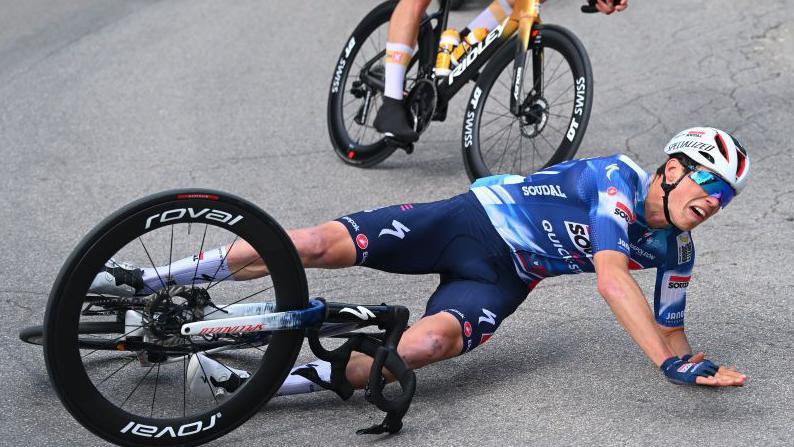It’s just over a year since Swiss teenager Muriel Furrer died after suffering a serious head injury at the UCI Road World Championships.
Furrer, 18, crashed during the junior road race in Zurich. Investigators quickly established there were no witnesses to the crash, and that Furrer had been found unconscious by a race marshal. How long that had taken remained a key question.
As a result, the UCI – cycling’s governing body – introduced GPS trackers for this year’s event in Rwanda, so the whereabouts of all riders were known at all times.
It was something the CPA – the cyclists’ union – believed should have been introduced years ago, and would have avoided injured riders being unaccounted for.
“It’s such an easy solution,” CPA president Adam Hansen told BBC Sport.
The investigation into Furrer’s death by Zurich police and the city’s public prosecutors’ office continues. It is something Hansen and the CPA “wish could go faster”.

Do riders worry about safety?
It’s not necessarily obvious to those outside of the sport just how dangerous road cycling is, but descending speeds that can exceed 60mph, limited protection against impact with hard or sharp objects on courses set up on the road, and a sense of the need to push the boundaries of risk in order to win underline the potential issues.
“A lot of the time we are in control of our own safety – the speeds we go, and when we brake,” says Tom Pidcock – a British winner of road races who is famed for astonishing descents on the bike.
“But we’re not racing F1 cars, where we’re protected, you’ve got a seatbelt and a helmet on, and someone fixes your car for you. If we crash, we’re the ones who take the hit.”
Kim le Court – an elite rider from Mauritius – injured her back in a big crash at this year’s Tour of Britain Women in Hartlepool.
Le Court, who developed her riding in South Africa in conditions she says were – at times – “bad”, hit the deck as riders jostled for position during a frantic start to stage two in wet conditions.
“We see it everywhere – it needs improvement,” she said. “For me, it’s hard to understand how it’s not safe in Europe. In Great Britain, the negative thing I saw was probably the potholes and lack of signs on the road.”
Le Court said there had also been issues during the Tour de France Femmes, referring to “some places where road islands were not pointed out” that was “really scary”.
“I can imagine how hard it is for them to get it perfect,” she said. “There are things that should change, and perhaps it’ll come in the near future.”
Briton Cat Ferguson, who won the race during which Furrer crashed, said safety had been “more on my mind than my legs hurting” during a recent event.
Why did it take so long to have trackers?
The trackers used in Kigali last month were dedicated to promoting safety for riders.
Trackers had been in operation last year in Switzerland, but were used mid-race for motorbikes to identify riders in groups focused on for television coverage, and only picked out those in the immediate vicinity of the motorbike.
And while Furrer’s transponder may have shown up on certain equipment, no-one was tasked with looking for ‘lost’ riders.
One of the reasons for delays in implementing an all-encompassing system was the ‘fight’ over riders’ data – which often includes crucial performance metrics such as power, heart rate and cadence. It is heavily protected intelligence when it comes to team strategy.
Some teams were reticent to lose control over data if a centralised system was able to harvest it.
That came to head in August, when five Women’s World Tour teams were disqualified from the Tour de Romandie Feminin after refusing to test the new trackers after an imposition from the UCI.

What do governing bodies and organisers say?
A British Cycling spokesperson said: “We work closely with local authorities and the UCI to ensure safety is paramount when staging major races like the Lloyds Tour of Britain.
“This includes carrying out detailed route reconnaissance in the lead-up to the events and working closely with local authorities to ensure the field of play is safe and that street furniture is appropriately flagged or removed.”
ASO, which organises the Tour de France Femmes, chose not to comment.
The UCI has been contacted for comment.
What needs to happen?
Trackers are one thing that can improve safety, but levels of anxiety among riders are obviously high.
One promising German rider – Louis Kitzki – even retired at the age of 21, citing the sport as too dangerous.
“The more chaotic a race became, the more brutally I broke down mentally,” he told Cycling Weekly.
Crashing and the resulting injuries are difficult to prevent in some circumstances, but in others they can be.
In 2023 – after the death of Swiss rider Gino Mader – the UCI introduced the SafeR – an initiative to improve all areas of safety in the sport.
But staying one step ahead of the game is harder than it needs to be, according to Hansen.
“The bigger races are generally very good,” he says. “But we need to be looking more forward in course design and get course [plans] ASAP to see the red flags and corners that are asking for trouble.”
A minimum budget for the smaller races to avoid the sort of cost-cutting that could result in cars and the general public straying into the path of the peloton would be a good start, according to Hansen.
He said some race organisers were trying to “hold their ground” and only when a crash happened might more input from the union be accepted.
Related topics
- Cycling
Source: BBC

Leave a Reply